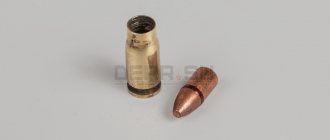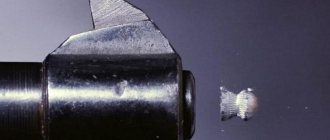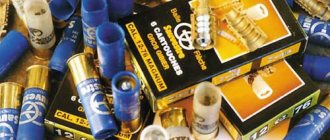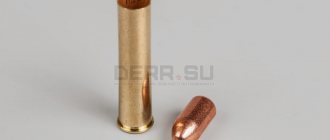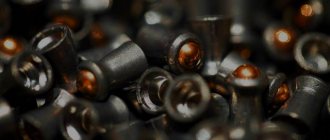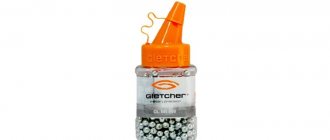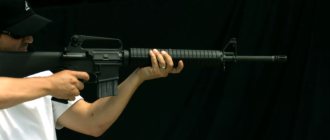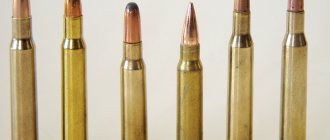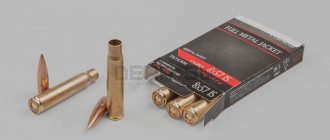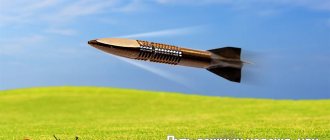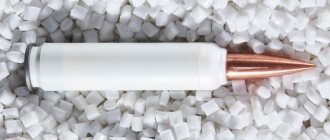Armor-piercing bullets
When conducting combat operations, a soldier cannot do without various special-purpose bullets: armor-piercing, tracer, incendiary, etc. Below we will talk about armor-piercing ammunition for small arms. The main purpose of armor-piercing bullets on the battlefield is to increase the likelihood of breaking through various obstacles, such as the sides and hulls of cars, personal protective equipment, and various shelters. Such bullets are special ammunition that expands the tactical possibilities of using small arms. In its simplest form, a pistol armor-piercing bullet is made entirely of a material harder than lead, for example, brass or steel. At the same time, the use of such bullets accelerates the wear of the weapon barrel, because of this, the usual version of the jacketed bullet is most often used, in which part or all of the lead core is replaced with a core made of steel or another harder alloy. In some modifications of domestic armor-piercing ammunition for small arms, the solid core in the head of the bullet is not covered with a shell, so that when breaking through any obstacle, energy is not wasted on deformation and penetration of the shell of the bullet itself by the core. Moreover, when hitting any unprotected target, armor-piercing ammunition behaves exactly the same as shell bullets with similar characteristics (velocity and mass).
For example, Russian pistol cartridges (5.45 mm PSM cartridge, 7.62 mm TT cartridge and 9 mm PM cartridge) have in their family bullets with conventional lead and steel armor-piercing cores. In addition to steel, tungsten carbide can also be used to make the bullet core. This material is 30% denser than lead and harder than steel; its main disadvantage is its high cost due to the complexity and high cost of processing tungsten carbide. Another promising material for developing cores is depleted uranium, which has an additional damaging effect.
Armor-piercing bullets have worse ballistic properties compared to conventional ammunition. Since such bullets are lighter than lead bullets, they “hold” their trajectory less well when firing at a long distance, and they have greater dispersion. Another disadvantage is their low effectiveness when firing at unarmored targets. Armor-piercing bullets have a low stopping effect. Such a bullet has less kinetic energy (due to lower mass) and does not change its shape when it hits the human body. Despite this, armor-piercing bullets are now in service with almost all armies of the world and are regarded as a fairly useful type of ammunition, especially in connection with the increasing spread of personal armor for military personnel (body armor).
Moreover, the first armor-piercing bullets were invented long before the first individual means of armor protection appeared on the battlefield. Initially, such bullets were intended mainly to combat armored vehicles. Even during the First World War, with the appearance of the first armored vehicles and tanks on the battlefield, the problem of effectively fighting them with small arms arose. The armor of the first tanks, not to mention ordinary armored vehicles, of that period could provide protection for the crew and vehicle components only from bullets and shrapnel. Machine gun and rifle fire with ordinary lead bullets was useless even against the lightest armor. But the gunsmiths were able to very quickly find a way out of this situation. They increased the strength of the bullet by incorporating a steel core into its design.
The Second World War and all the local wars and conflicts that followed it clearly demonstrated the increased importance of the use of armor-piercing bullets for handguns (pistols, machine guns, rifles, machine guns), as well as heavy machine guns, which can be used as an effective means of supporting infantry on the battlefield ( heavy machine guns) or weapons for armored vehicles, helicopters, UAVs and aircraft.
12.7 mm bullet 57-BZ-542 in section
One of the most important characteristics for any armor-piercing bullet is its penetration or penetration effect. Penetrating action is the depth of penetration of a bullet into an obstacle that has a certain density. This characteristic of the ammunition directly depends on the caliber of the bullet, its mass, initial speed, design and shape, angle of impact with the obstacle and its density. Any armor-piercing bullet exhibits the greatest penetrating effect at an angle of contact with an obstacle of about 90 degrees. It is not for nothing that armored vehicle designers prefer the use of inclined armor, which provides it with the highest level of protection against damage from various armor-piercing penetrating ammunition.
12.7 mm cartridges have the greatest armor penetration. For example, the widely used 12.7-mm armor-piercing incendiary cartridge 57-BZ-542, which is used in the NSV-12.7 Utes and Kord machine guns or large-caliber ASVK Kord sniper rifles, is capable of penetrating up to 20 -mm of armor at a distance of up to 100 meters. An armor plate of this thickness penetrates in at least 90% of cases. At the same time, the incendiary effect of a bullet on gasoline located behind the 15th armor plate at a distance of 70 meters is at least 75%. It is quite simple to distinguish a domestic armor-piercing bullet from a conventional one; its upper part is painted black. The armor-piercing incendiary bullet has a red bordering strip under the black tip.
Our gunsmiths occupy a worthy place in the creation of armor-piercing ammunition for small arms, and Russia is one of the leaders in this direction. Our gunsmiths managed to create a whole range of armor-piercing cartridges for all major types of Russian small arms, starting with 7.62 and 12.7 mm armor-piercing cartridges (40-50s) and ending with modern 5.45x39, 9x21 and 9x39 mm armor-piercing cartridges cartridges. At the same time, Soviet and Russian designers managed to develop not only armor-piercing ammunition with high penetration ability, but also ensuring a fairly high accuracy of fire in bullets of complex design, which is quite difficult to achieve technologically.
In modern armies, armor-piercing bullets are used primarily to combat enemy personnel protected by body armor or located behind various shelters, to destroy unarmored and lightly armored vehicles and enemy fire weapons, as well as to destroy various air targets. The use of armor-piercing bullets became especially relevant in the 1970-80s, when individual armor protection, primarily body armor, began to appear en masse in the arsenal of modern armies.
The core of armor-piercing bullets is usually made of various types of high-carbon steel, as well as its alloys (high-alloy steel with the addition of tungsten). In this case, the core of an armor-piercing bullet is located inside its body (shell) in a special lead jacket, which provides it with a fixed position and makes it easier for the bullet to cut into the rifling of the barrel, protecting the barrel itself from premature wear. Most often, the shell of an armor-piercing bullet is made of bimetal. The vast majority of modern bullets use tombak alloy, which consists of 89-91% copper and 9-11% zinc. Armor-piercing cartridge cases are no different from ordinary ones; they are made of mild steel or brass coated with varnish or tombac. All modern small arms ammunition uses pyroxylin gunpowder as a propellant charge.
In most modern ammunition, the action of armor-piercing bullets is combined with incendiary (such bullets are called armor-piercing incendiary) and tracers (armor-piercing incendiary tracer or armor-piercing tracer). Such ammunition combines optimal armor-piercing action with incendiary action. Most often, the incendiary composition is placed at the rear of the bullet and is a self-igniting substance with enhanced initiating properties.
At the same time, in modern combat operations, the role of such ammunition in combating enemy personnel protected by body armor has grown significantly. However, it makes no sense to fully provide small arms with only armor-piercing ammunition, since they are more expensive to manufacture, and real combat operations require the presence of cartridges with different characteristics in a soldier’s ammunition. To successfully carry out combat missions, machine gun belts or machine gun magazines can be equipped with various ammunition, followed by their alternation.
For example, for night combat, an assault rifle or machine gun can be equipped with one cartridge with a tracer bullet, two with an ordinary bullet and one with an armor-piercing bullet, and so on. If stealth is required from a soldier or unit, then when equipping magazines and belts, ordinary bullets can be alternated with armor-piercing incendiary bullets. For example, in the mountains day and night, using armor-piercing incendiary bullets, it is convenient to adjust the fire, guided by the explosions of such bullets on rocks. To effectively engage air targets, every third or second cartridge must be a tracer.
Sources of information: https://vooruzhen.ru/news/139/6172 https://www.straikbol.ru/weapons_and_equipment/2013/11/14/broneboynye-puli.html https://world.guns.ru/ammunition /pistol-cartridges-r.html https://vitaly.chuyakov.ru/337-puli-bronebojjnye-zazhigatelnye-trassirujushhie-i.html
And again 5.45
In parallel with the rifle program in 2010-2012. At the Amur cartridge chamber, work was carried out to modernize the standard 5.45x39 machine gun cartridge under the code cipher “Igolnik”. As part of this program, it was necessary to create a 5.45-mm armor-piercing cartridge with increased penetration with a metal-ceramic (carbide) core under the symbol 7N39. This development was also carried out in cooperation with TsNIITOCHMASH and TekhKomplekt LLC. There is very little information about this ammunition in open sources, and basically we can only rely on data from patent documentation. The general design of the new bullet and the rationale for its advantages were presented in RF Patent No. 2438092 dated July 9, 2010, the authors of which are representatives of TekhKomplekt LLC,
Components of the “Type No. 4” bullet individually (tombak jacket, core and lead jacket-pan), and they after final installation (before crimping the tail of the bullet)
TsNIITOCHMASH and the Amur Cartridge Plant.
The 7N39 increased penetration cartridge was adopted for service by order of the Ministry of Defense of the Russian Federation No. 293 dated April 17, 2013. With a high degree of probability, it can be assumed that the 7N37 cartridge was also adopted on the basis of the same order. The new cartridge was given the symbol 5.45 PPBS; its distinctive feature is the marking of the top of the bullet with black paint on 2/3 of the part visible from the cartridge case. The declared armor penetration characteristics of the bullet are: 100% penetration of a 5-mm sheet of armor steel grade 2P from an AK-74 at a distance of 550 m and 100% penetration of a 10-mm sheet of grade 2P from an RPK-74 machine gun at a distance of 100 m.
Types of pneumatic bullets
The accuracy of hitting the target depends both on the characteristics of the weapon and the experience of the shooter, as well as on the cartridges used. Today you can choose the following ammunition, which is used for different purposes:
- Conical bullets can be fired from the barrel at supersonic (over 335 m/s) or subsonic speeds. Moreover, the higher the flight speed, the more “elongated” it should be. The profile surface often has notches or ribs that increase the accuracy of the shot.
- Cap bullets are cylindrical in shape. Certain types are made with transverse grooves or longitudinal stiffeners. As a rule, they are used for smooth-bore shotguns. Thanks to the hollow rear part, the center of gravity shifts forward, this avoids the “twisting” of the bullet during flight. These cartridges are effective at long distances (up to 100 m).
- Flat-nosed pellets are the best choice for athletes when shooting at short range targets. In some cases, they are used to shoot rodents. Due to its shape, the bullet loses speed after 15 m.
- Hemispherical bullets are the cheapest and simplest in shape. They can be used for hunting or training, they performed well when shooting at medium distances.
- Explosive bullets, upon impact with a target, explode from a detonating substance (usually bertholite salt is used), a bright flash can be seen and the sound of an explosion can be heard. Most often they are used for demonstration shooting.
- Expansive cartridges are used for hunting. These bullets are best used for medium range shooting. There is a depression in the head of the bullet, due to which, when it hits the target, the bullet turns and expands, increasing the affected area. For maximum effect, you should choose pneumatics that provide an initial flight speed of more than 320 m/s.
- Cleaning bullets are made of felt; they perfectly clean the inside of the barrel, removing remaining grease and small particles of lead. It is recommended to clean the barrel every 500 shots. If the gun is powerful, you can load several bullets at the same time. 3-4 shots are enough for cleaning.
- Spherical balls can be lead or copper plated. The latter are made of steel and coated with copper, which helps prevent the formation of corrosion on the bullet, reducing barrel wear. Lead bullets are highly accurate. The composition contains antimony, which increases the strength of the ammunition and reduces ductility during flight.
Airguns
Armor-piercing cartridges for pneumatics are called so very conventionally. They won’t penetrate real armor, but their impact characteristics are higher than those of classic lead balls or “herringbones”.
The highlight in the design: the core is made of steel, brass or other solid material. Accordingly, when the projectile reaches the target, it does not deform, but penetrates deeper. The sleeve (usually made of plastic or lead) flies off to the side.
Armor-piercing pneumatic cartridges are used for sporting purposes or ordinary entertainment in the form of shooting at cans, bottles or barrels in nature. Popular in city shooting ranges and recreational shooting ranges. Increased penetrating ability increases the interest in shooting, and the projectile remains inside the target and does not bounce, which makes training at the shooting range safer. However, in terms of ballistic characteristics, the projectile is inferior to conventional bullets, and therefore is almost never used for hunting.
Packages from manufacturers Umarex, H&N, GAMO and many others are available in stores. Cartridges of various shapes and calibers.
Story
Tracer bullets were invented before 1914. Ammunition of this type produced a trail in the form of fire or smoke, which contributed to effective shooting adjustments. This was especially important when firing at aircraft at night. English and French tracer bullets have a special design. They were produced with sizes increased in length. On the back of them there is a recess that is half or a third of the length of the bullet. During the production process, a special composition is pressed into it. It is capable of burning red, green or white fire.
At first, the visibility of the bullet trace was insignificant and was about 350 meters. In 1918, this figure was increased to one kilometer. If the ammunition design includes a lead core, the tracer compound is first placed in a special cup. This manipulation avoids melting of the part as a result of combustion of the composition and the formation of high temperature. The English tracer bullet has a similar device. In this case, the composition in it is ignited by the powder gases of the charge.
Purpose of cartridges
14.5-mm cartridges with B-32, BS-41, BZT and BST bullets are intended to destroy lightly armored ground targets at ranges up to 1000 m, unarmored targets, enemy fire weapons and group targets - up to 2000 m, as well as air targets at altitudes up to 1500 m.
In addition, cartridges with a BZT bullet are intended for adjusting fire and can be used for target designation. The tracing range of a BZT bullet is at least 2000 m, the bullet’s path is red, visible day and night.
14.5 mm cartridges with BS-41 and BST bullets have better armor-piercing ability than cartridges with B-32 and BZT bullets.
In addition, the BST bullet has a number of advantages compared to the BS-41 bullet, including greater armor-piercing and incendiary ability and the presence of a tracer effect.
The tracing range of a BST bullet is at least 1500 m, the trace is red, visible day and night.
14.5-mm cartridges with a ZP bullet are intended for hitting open ground targets, igniting wooden buildings, haystacks, straw and other flammable objects, fuel located in tanks and tanks not protected by armor at ranges of up to 1500 m.
The ZP bullet has a tracer. The tracking range of the ZP bullet is at least 1500 m, the trace is red, visible day and night.
The cartridge with the MDZ bullet is designed to engage air targets at ranges up to 2000 m. The MDZ bullet, having high-explosive fragmentation and incendiary effects, ensures the defeat or damage of air targets by fragments and a blast wave, as well as the ignition of flammable liquids located in tanks with a wall thickness of 2 to 8 mm, at ranges up to 2000 m.
14.5 mm training cartridges are intended for training troops in loading, unloading and firing techniques, as well as for studying the operation of machine gun automation.
Cartridge (capping) box
The cartridges are delivered to warehouses and military units sealed in wooden boxes. Such containers serve as transport and storage containers and are used for storing and transporting these cartridges.
Each box contains two, under one of which a fabric tape is placed for easy removal.
Cartridge boxes are manufactured in accordance with GOST V 1806-75 (ST V SEV 0108-82) “Wooden boxes for small arms cartridges. Technical conditions.” from coniferous trees (spruce, pine, fir, cedar), except for the bottom and lid, which are made of fiberboard. Since 1985, it has been allowed to make the side end walls of the box from larch lumber. The cover of the cartridge box is hinged and attached to its body using metal fittings. In addition, the box has two wooden handles for carrying. Until 1979, cartridge boxes were made entirely, including the bottom and lid, of wood with the lid attached to the body of the box with screws.
According to the information available to me, according to the GRAU index, there are two types of cartridge boxes
- 57-Я-001
capping box (wooden) devil. 3-2822 “a”, 4-2833. Application: 7.62 mm rifle cartridges 57-B-322 (7.62 B hl), 57-B-323 (7.62 B-30 gzh), 57-BZ-322 (7.62 B-32 hl ), 57-BZ-323 (7.62 B-32 gz), 7.62 B-32 gs, 57-BZT-322 (7.62 BZT gl), 57-BZT-323 (7.62 BZT gz) , 7.62 ZB-46 gzh, 7.62 BZT gs, 57-BT-322 (7.62 BT gl), 7.62 BT gzh, 57-D-422 (7.62 D gl), 57-D -423 (7.62 D gz), 7.62 D gs, 57-DD-322, 57-DD-323, 57-Z-322 (7.62 Z gl), 57-Z-323 (7.62 Z gzh), 57-ZP-322 (7.62 PZ gl), 57-ZP-323 (7.62 PZ gzh), 7.62 PZ gs, 57-N-321 (7.62 L gl), 57 -N-322 (7.62 L gl), 57-N-323 (7.62 L gz), 7.62 L gs, 57-N-323S (7.62 LPS gzh), 57-N-323S- 01 (7.62 LPS gs), 57-N-323U, 57-P-322 (7.62 P gs), 57-T-322 (7.62 T gs), 57-T-322 (7.62 T-46 gl), 57-T-323 (7.62 T-46 gzh), 7.62 T-46 gs, boxes 6-Ya-141, 6-Ya-153, 20 mm ShVAK cartridges - 57-Я-005
– capping box (wooden). Application: 7.62 mm rifle cartridges 57-B-322 (7.62 B hl), 57-B-323 (7.62 B-30 gzh), 57-BZ-322 (7.62 B-32 hl ), 57-BZ-323 (7.62 B-32 gz), 7.62 B-32 gs, 57-BZT-322 (7.62 BZT gl), 57-BZT-323 (7.62 BZT gz) , 7.62 ZB-46 gzh, 7.62 BZT gs, 57-BT-322 (7.62 BT gl), 7.62 BT gzh, 57-D-422 (7.62 D gl), 57-D -423 (7.62 D gz), 7.62 D gs, 57-DD-322, 57-DD-323, 57-Z-322 (7.62 Z gl), 57-Z-323 (7.62 Z gzh), 57-ZP-322 (7.62 PZ gl), 57-ZP-323 (7.62 PZ gzh), 7.62 PZ gs, 57-N-321 (7.62 L gl), 57 -N-322 (7.62 L gl), 57-N-323 (7.62 L gz), 7.62 L gs, 57-N-323S (7.62 LPS gzh), 57-N-323S- 01 (7.62 LPS gs), 57-N-323U, 57-P-322 (7.62 P gs), 57-T-322 (7.62 T gs), 57-T-322 (7.62 T-46 gl), 57-T-323 (7.62 T-46 gzh), 7.62 T-46 gs
The dimensions of the cartridge box 57-YA-005 are 488x350x163 mm, the weight of an empty box varies between 3.6-4.0 kg. The difference between the gross and net weight of the box (the total weight of the cartridges contained) is approximately 7 kg.
Also, a special knife is inserted into the cartridge box to open the zinc. In boxes with a lid made of fiberboard, the knife is placed in a slot on the inside of the end wall of the box, and in boxes with a lid made of wood - in the corresponding slot on the inside of the lid. The knife is placed with the cutting part inward.
The sealed cartridge box is tightly covered (tied) with steel packing tape. The ends of the tape are connected mechanically with sealing or welding.
| Boxes of cartridges 7.62 mm mod. 1943 with PS bullets, old version with plank cover |
| Box of 7.62 mm rifle cartridges with LPS bullets, old, used before 1990, variant marking on the lid (gross weight and transport mark - number “2” in a triangle) |
| Ammo box 5.45 PS (7N6) |
| Box of cartridges 7.62 PS (7N1), export marking on the lid |
Marking of cartridge wooden box
Markings on a wooden cartridge box are applied to the lid and on one side wall.
The lid indicates the gross weight, the conventional number of the dangerous cargo in an equilateral triangle (for most types of cartridges these are the numbers “450
“, for cartridges with an MDZ bullet - “
263
”, for blanks - “
471
”) and the classification code for the transport danger of the cargo “1.4 S” (code “1.4” according to GOST 19433-88 means “Explosive materials that do not pose a significant danger”) . The box with training cartridges is not marked with a cargo discharge sign or a dangerous cargo symbol number and a marking on the transport danger of the cargo.
